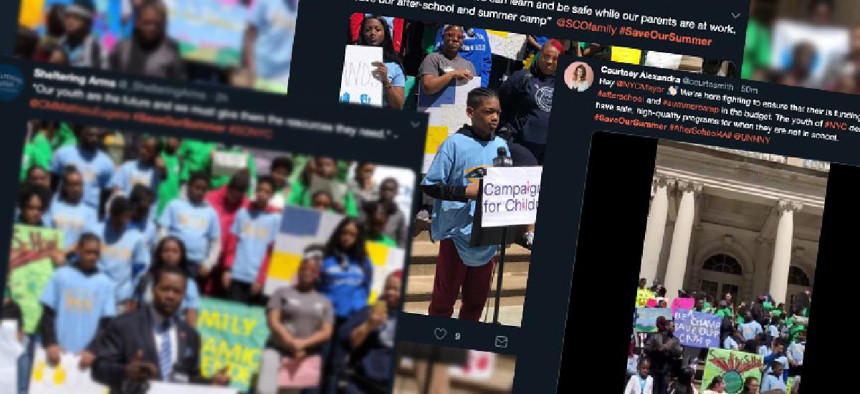Nonprofits push to #SaveOurSummer

Advocates at an April 24 rally outside New York City Hall. Twitter
A new report examines childhood lead exposure in New York City. There has been an 89% decrease in the number of children with elevated blood levels – defined as 5 mcg/dL or greater – since 2005, according to the report from the city health department. Despite the recent controversy about lead exposure in public housing, the report asserts that “children associated with public housing typically have lower rates of elevated blood lead levels than children living in private housing.” The number of children with elevated blood lead levels in private housing declined by 11% from 2017 to 2018, with 4,579 cases reported last year.
Three nonprofit leaders were selected by Mayor Bill de Blasio to serve on the Civic Engagement Commission. The eight commissioners will oversee efforts on three fronts: establishing a citywide participatory budgeting program, providing interpreting services at poll sites, and helping to make community boards more representative of their own constituents, according to an April 23 press release. The commission was established after voters approved a ballot initiative last year created by the 2018 Charter Revision Commission.
Here’s a rundown of the nonprofit pros who will serve as commissioners.
- Murad Awawdeh is the vice president of advocacy at the New York Immigration Coalition.
- José Hernandez is the president of the local chapter of the United Spinal Association.
- Linda Lee is executive director of the Korean Community Services of Metropolitan New York.
- Annetta Seecharran is executive director of Chhaya CDC.
The city Department of Youth and Community Development is planning to extend dozens of contracts for the Comprehensive After School System. The contracts range in size from about $100,000 to more than $1 million for the program, which supplements classroom learning with academic, recreational and cultural activities for children. See the full list here of which nonprofits are getting their contracts extended through August 2020.
There is a new vice president of policy and collaboration at Philanthropy New York. Rico Blancaflor is taking on the position after spending 20 years with the Posse Foundation. “He brings to PNY a deep knowledge of racial equity work, a set of outstanding facilitation skills, and a keen understanding of policy issues that affect first-generation low-income college students, including financial stability, education policy, and immigration,” reads an April 24 press release.
Nonprofits and elected officials rallied at New York City Hall on Wednesday to #SaveOurSummer. Advocates say that Mayor Bill de Blasio’s proposed budget for the upcoming fiscal year would eliminate funding for more than 7,000 after-school summer camp slots. Representatives of United Neighborhood Houses of New York, Children’s Aid, and Sheltering Arms were at the rally alongside members of the City Council, including Stephen Levin, Mattieu Eugene, and Carlina Rivera.
.@ChildrensAidNYC East Harlem Center is here representing #summercamp - @NYCMayor we need YOU to #saveourcamp pic.twitter.com/VhtmCjrFdl
— Keyla Espinal (@KeylaEAntigua) April 24, 2019
A new survey from Women in Need finds that New Yorkers are open to homeless shelters in their neighborhoods. While individual shelters have attracted local opposition in the city (like here and here) there is widespread support for doing more to address homelessness citywide, according to the survey conducted by HarrisX on behalf of WIN. Nearly 60% of the 1,002 survey respondents said they would support a homeless shelter hoping in their neighborhood.
One takeaway from the survey is that more education could counter mistaken beliefs about homeless people. Here are two examples taken more or less verbatim:
- When most New York City residents picture the face of the city’s homeless population, they forget a huge swath of the homeless population – families with children, which make up about 70% of the homeless population.
- While one-third of homeless families in shelters have a working adult, 67% of New York City residents think that most people who are homeless in New York City are unemployed (versus believing that most people who are homeless in New York City have a job).
